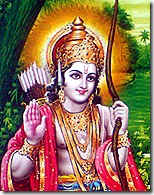 “Subsisting on fruits and milk, chant Shri Rama’s holy name for six months. Tulsidas says that by following this formula all auspiciousness and every perfection will arrive in the palm of your hand.” (Dohavali, 5) “Subsisting on fruits and milk, chant Shri Rama’s holy name for six months. Tulsidas says that by following this formula all auspiciousness and every perfection will arrive in the palm of your hand.” (Dohavali, 5)paya ahāra phala khāi japu rāma nāma ṣaṭa māsa| sakala sumaṇgala siddhi saba karatala tulasīdāsa || The ancient art of mysticism [yoga] originating from India is indeed a very potent form of spiritual practice. More than just exercise and breathing routines aimed at providing benefits to one’s overall health, real yoga, when practiced properly and to fruition, brings about various siddhis, or mystic perfections. These are powers and abilities unknown to most, as just even hearing their descriptions is enough to turn the most interested observers into skeptics. Real yogis can make themselves very large or small at the drop of a hat. They can travel outside of their body and produce objects at a whim. They can survive through a burning fire and remain alive while knee deep in a river that is ice cold. Yet, for the devotee these mystic perfections, which come about through strict austerity and dedicated practice, are really not worth anything in the absence of a relationship to the Supreme Lord. Rather, one who is in concert with the divine consciousness and the dictates coming from the spiritual sky will always be in a pleasurable condition and be given all the tools necessary for the performance of their assigned duties. Goswami Tulsidas accurately points out in this verse that all the auspiciousness and perfections that come from yoga practice can be similarly attained with minimal effort through a slight alteration in the targeted beneficiary.  Yoga’s popularity today shouldn’t be that difficult to understand. After all, who wouldn’t want to improve their health? If we are sick and constantly diseased, how can we enjoy any aspect of life, spiritual or otherwise? Yet the true Vedic scholars, those whose eyes have been anointed with the salve of transcendental love, or premanjana, understand that any ability or peaceful condition that doesn’t lead to a proper shift in consciousness is not very worthwhile. Even the body, which is given highest precedence as far as maintenance goes for the individual, is destined for destruction. Only the animal species and those human beings who have not yet reached their full potential for intelligence think that everything finishes at the time of death. Due to this ignorance, the immediate satisfaction of the body and its prolonged health achieved through great endeavor are seen as the paramount responsibilities, interests which supersede all others. Yoga’s popularity today shouldn’t be that difficult to understand. After all, who wouldn’t want to improve their health? If we are sick and constantly diseased, how can we enjoy any aspect of life, spiritual or otherwise? Yet the true Vedic scholars, those whose eyes have been anointed with the salve of transcendental love, or premanjana, understand that any ability or peaceful condition that doesn’t lead to a proper shift in consciousness is not very worthwhile. Even the body, which is given highest precedence as far as maintenance goes for the individual, is destined for destruction. Only the animal species and those human beings who have not yet reached their full potential for intelligence think that everything finishes at the time of death. Due to this ignorance, the immediate satisfaction of the body and its prolonged health achieved through great endeavor are seen as the paramount responsibilities, interests which supersede all others.Those trained in the high philosophy that accompanies real spiritual life understand that the soul should actually be given first billing. One may acquire a big house and land an important job, but eventually everything will be finished. As life in the phenomenal world existed prior to our birth, it will continue to remain manifest long after we have left our present body. As such, we can conclude that life itself is eternal, incapable of being destroyed. The plight of the spiritual spark, the catalyst for action in any form which is deemed full of life, is the top priority for the intelligent human being, one who understands the eternal nature of the soul and what it takes to get placed into a body that never dies and never fails to provide satisfaction. The pitfalls of strict dedication to yoga practice in the absence of advancement in God consciousness can be understood by studying the results of fruitive activity, or karma. For those who are a little advanced and have transcended the base animalistic tendencies of seeking after immediate satisfaction of the senses, there are generally three different paths available for spiritual progress, not including the sublime and most fruitful path known as bhakti. Understanding that hedonism is not the answer to life’s problems, the mature human being can take to fruitive activity [karma], study of the differences between matter and spirit [jnana], or meditational mysticism [yoga]. Karma is reserved for those seeking heightened pleasures through regulated activity. The majority of those who consider themselves religious follow the karma path, as they seek to maintain a steady level of piety and decency of conduct in order to be benefitted in the future, through rewards that either aid health and family or bring ascension to a heavenly realm. The philosopher route brings about a change in thought processes, but behavior isn’t really altered except for maybe the elimination of certain activities. Therefore jnana remains a purely theoretical path, one that can only lead to the negation of all activity and the ultimate merging into a spiritual effulgence of bliss, wherein the identity of the individual is lost.  Mystic yoga, though seemingly a combination of karma and jnana, is actually more similar to karma. To understand the similarities, let’s take the example of a marathon runner. Karma in the spiritual sense typically involves work aimed at pleasing a divine figure or set of godly authorities in charge of distributing results. Karma in the absence of spiritual life is wholly dedicated to satisfying the senses through specific work. Training for a marathon is a unique practice because it actually seeks sense gratification through the formation of a skill; hence the similarity to mystic yoga. One who trains to run a marathon must go through so many austerities. Diet must be altered, drinking and smoking should ideally be cut out, and intense practice must be performed. Running a marathon is no joke after all, so if you want to complete all 26.2 miles in one stretch in a decent time, you have to be very physically fit. Mystic yoga, though seemingly a combination of karma and jnana, is actually more similar to karma. To understand the similarities, let’s take the example of a marathon runner. Karma in the spiritual sense typically involves work aimed at pleasing a divine figure or set of godly authorities in charge of distributing results. Karma in the absence of spiritual life is wholly dedicated to satisfying the senses through specific work. Training for a marathon is a unique practice because it actually seeks sense gratification through the formation of a skill; hence the similarity to mystic yoga. One who trains to run a marathon must go through so many austerities. Diet must be altered, drinking and smoking should ideally be cut out, and intense practice must be performed. Running a marathon is no joke after all, so if you want to complete all 26.2 miles in one stretch in a decent time, you have to be very physically fit.For most people training to run a marathon, the aim is to simply complete the race using a moderate pace that is free of any stops and periods of walking. Many individuals have achieved this goal, and afterwards they felt tremendous satisfaction. There is a great sense of accomplishment, that something seemingly impossible can be achieved through hard work and dedication. Indeed, those who train for running marathons often have something they are trying to prove or someone they are running away from. The loneliness of the long distance runner brings some peace and calm to the mind, as no one else is out there to support you except yourself. The thrill and exhilaration from completing something so difficult all by yourself brings about a great boost in self-esteem. So let’s say that we train for and complete a marathon. Our self-esteem is now higher, and we’ve proven to ourselves that we can do anything we set our mind to. But now what? Where do we go from here? Won’t any other activity follow a similar pattern? After training very hard to complete specific tasks and seeing the successful completion of the mission, won’t we be left to find a new task afterwards? This is actually the situation faced by the mystic yogi, who, after great endeavor and strict austerity, attains tremendous powers, capabilities that far exceed those exhibited by ordinary individuals. Indeed, the most famous cheaters in the realm of spirituality, those who have claimed to be God in human form, have been mystic yogis who showed off some perfection, such as disappearing or creating some other magic, to support their claims of divinity. Many innocent, and at the same time gullible, people were misled into believing these erroneous claims, and hence they took to the wrong path of spiritual life, one that brought no benefit at all. 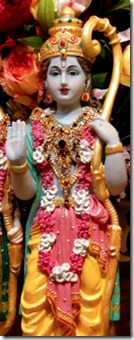 If yoga performed through such great endeavor can lead the person to thinking that they have become God, how can we honestly say that any tangible benefit is derived from the practice? Taking oneself to be God is the most glaring indication of insanity. This is the point raised by the devotees, those who transcend karma, jnana and yoga and take only to bhakti, or divine love. The key to happiness and eternality of pure emotion is a properly situated consciousness, where the mind is always tied to the interests of the most powerful divine lover, the supreme object of pleasure. In the Vedic tradition, this entity, who is known as God around the world, is described by thousands of names such as Krishna and Rama. God is certainly the most attractive individual, and He can also bring about the greatest transcendental pleasure to His devotees. Hence the names Rama and Krishna are completely bona fide and non-sectarian. Every single person is open to worshiping the Supreme Lord as Rama or Krishna, though the general tendency for the ignorant is to remain far away from the Lord’s direct presence, not even taking to explicit worship. If yoga performed through such great endeavor can lead the person to thinking that they have become God, how can we honestly say that any tangible benefit is derived from the practice? Taking oneself to be God is the most glaring indication of insanity. This is the point raised by the devotees, those who transcend karma, jnana and yoga and take only to bhakti, or divine love. The key to happiness and eternality of pure emotion is a properly situated consciousness, where the mind is always tied to the interests of the most powerful divine lover, the supreme object of pleasure. In the Vedic tradition, this entity, who is known as God around the world, is described by thousands of names such as Krishna and Rama. God is certainly the most attractive individual, and He can also bring about the greatest transcendental pleasure to His devotees. Hence the names Rama and Krishna are completely bona fide and non-sectarian. Every single person is open to worshiping the Supreme Lord as Rama or Krishna, though the general tendency for the ignorant is to remain far away from the Lord’s direct presence, not even taking to explicit worship.This is the misfortune of the souls who follow paths in life that are not authorized and incapable of providing the highest bliss. In every other field of activity, the ultimate objective is pleasure, so why should this property be absent in spiritual life? God is meant to provide the greatest pleasure to the soul, as He is its life companion. Just as the sun shines equally over all the land, the Lord’s mercy is universally available. The differences in outcomes to action are seen due to the variations in degrees to which that mercy is taken and made use of. Only the bhaktas, the pure devotees whose thoughts always remain focused on God, understand, appreciate, and never take for granted the divine mercy shown to them. 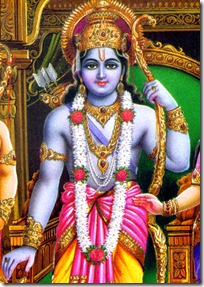 Depending on the specific tradition followed, either Lord Krishna is taken as the original form of Godhead or Lord Vishnu is, with Krishna and Rama considered His incarnations. In either case, since all the personal expansions of the original Supreme Lord are extremely potent and non-different in their ability to provide salvation and eternal pleasure, the devotee’s viewpoint in this regard is not that important. Indeed, the topmost devotees of Shri Krishna are those who don’t even look at Him as being God. They simply think of Krishna as their best friend, their most intimate life partner whose interests always remain paramount. Depending on the specific tradition followed, either Lord Krishna is taken as the original form of Godhead or Lord Vishnu is, with Krishna and Rama considered His incarnations. In either case, since all the personal expansions of the original Supreme Lord are extremely potent and non-different in their ability to provide salvation and eternal pleasure, the devotee’s viewpoint in this regard is not that important. Indeed, the topmost devotees of Shri Krishna are those who don’t even look at Him as being God. They simply think of Krishna as their best friend, their most intimate life partner whose interests always remain paramount.Goswami Tulsidas, a celebrated Vaishnava poet, views Lord Rama, the expansion of Godhead appearing on earth during the Treta Yuga, as his most worshipable object. Even one who is a Krishna or Vishnu devotee can take great pleasure and knowledge from Tulsidas’ teachings, which are perfect, sublime and always relevant. In the above referenced verse from the Dohavali, Tulsidas is specifically tackling the issue of meditational yoga. Every reference made herein has a direct link to the practices and rewards of mysticism. Tulsidas presents the well-known principles of mystic yoga and makes a comparison to the same practices and results when applied to the realm of bhakti, whose quintessential practice is the chanting of the holy names of God, such as those found in the maha-mantra, “Hare Krishna Hare Krishna, Krishna Krishna, Hare Hare, Hare Rama Hare Rama, Rama Rama, Hare Hare”.
 Tulsidas is especially fond of chanting Rama’s name, as the name of the Lord automatically invokes memories of His forms, pastimes and qualities. As mentioned in the Bhagavad-gita by Lord Krishna Himself, to practice yoga properly one must find a secluded place and a comfortable sitting area where no insects or other distractions will be present. There must be complete celibacy and strict adherence to meditation while remaining seated in an erect posture. Food and drink also play an important role, as the acquisition of various siddhis requires austerity in food intake. The secret behind the effectiveness of meditational yoga is the reduction of the influence of the senses. In the conditioned state, the senses play an integral role in shaping behavior; therefore one who is interested in advancing spiritually and making full use of the massive potential for meaningful activity found within the soul must control their senses. Of all aspects of the material body, the urges of the tongue and genitals are the most difficult to control. Hence they form the main focus of austerity in spiritual practice, especially in meditational yoga. There must be complete celibacy for a bona fide yogi, and the urges of the tongue must be controlled as well. Tulsidas is especially fond of chanting Rama’s name, as the name of the Lord automatically invokes memories of His forms, pastimes and qualities. As mentioned in the Bhagavad-gita by Lord Krishna Himself, to practice yoga properly one must find a secluded place and a comfortable sitting area where no insects or other distractions will be present. There must be complete celibacy and strict adherence to meditation while remaining seated in an erect posture. Food and drink also play an important role, as the acquisition of various siddhis requires austerity in food intake. The secret behind the effectiveness of meditational yoga is the reduction of the influence of the senses. In the conditioned state, the senses play an integral role in shaping behavior; therefore one who is interested in advancing spiritually and making full use of the massive potential for meaningful activity found within the soul must control their senses. Of all aspects of the material body, the urges of the tongue and genitals are the most difficult to control. Hence they form the main focus of austerity in spiritual practice, especially in meditational yoga. There must be complete celibacy for a bona fide yogi, and the urges of the tongue must be controlled as well.To acquire a desired siddhi, generally at least six months of steady dedication to yoga is required. In the absence of the recommended conditions and practices, there is little chance of any tangible benefit coming from the ancient yoga system. Yet Tulsidas says that instead of limiting your food and drink intake to nothing or next to nothing, just take simple milk and fruits and consume them in portions you are already accustomed to. Implied in this recommendation is that one refrain from sinful foods such as those in the mode of darkness and restricted items such as animal flesh. During Tulsidas’ time, medieval India, meat eaters and those addicted tointoxication never really took to any prescribed Vedic practices, for such people were considered outcastes in all respectable spiritualist circles. Instead of severely limiting the intake and portion size of fruits and milk, one can continue eating the amounts that already satisfy them. For instance, if our usual meal consists of a glass of milk and two bananas, there is no need to change. The key point made by Tulsidas is that instead of remaining dedicated to some difficult yoga practice for six months, chant Rama’s name for just as long a period. There is no need to starve or punish yourself during this time. Just eat some nice fruit, drink milk, and chant the Lord’s name repeatedly. Indeed, through this formula every auspicious result [sakala sumangala] and every mystic perfection [saba siddhi] will come in the palm of your hand [karatala].
Is there some disingenuousness in these promises? Will chanting God’s name for that long a period enable us to perform wonderful feats of magic and have out of body experiences? The difference with the bhakti formula is the altering of consciousness that results, something absent in other forms of spiritual practice. Karma may bring about respect for higher authority figures and a temporary future condition that is pleasant, jnana an increase in knowledge, and yoga a feeling of pride and accomplishment in activity, but none of these engagements links one directly with the ultimate reservoir of pleasure, the Supreme Personality of Godhead. 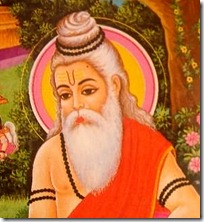 On the other hand, one who regularly chants Rama’s name is in direct connection with the Supreme Lord, even if they are averse to the practice in the beginning stages. The holy name is the most potent incarnation of this age; hence it forms the bedrock of the religion of love, bhakti-yoga, or devotional service. The saints like Tulsidas know that in the conditioned state the majority of spiritualists are only interested in finding auspiciousness or mystic ability, so it is better to simply ask them to chant without initially explaining all the ins and outs of consciousness and the need for altering it. Indeed, this is how a famous reformation once took place. Maharishi Valmiki, a great sage whom Tulsidas is considered to be an incarnation of, was a dacoit in his early life. Having the great fortune of one day meeting Narada Muni, arguably the world’s greatest reformer, Valmiki was advised to give up his stealing and simply chant Rama’s name. Since Valmiki was unable to say “Rama”, Narada told him to chant “Mara” instead, as repeating this sound over and over again would produce the name of Rama just the same. Narada didn’t explain anything important to Valmiki at the time, nor did he tell him what chanting would bring. After subsequently chanting for a long period of time, so engrossed in the holy name was the dacoit that an anthill eventually formed around him; hence he was given the spiritual name of Valmiki by Narada. Through chanting Valmiki attained the auspiciousness of a purified consciousness and the perfection of being able to write the famous Ramayana poem, a celebrated Sanskrit work which describes the life and pastimes of Lord Rama. On the other hand, one who regularly chants Rama’s name is in direct connection with the Supreme Lord, even if they are averse to the practice in the beginning stages. The holy name is the most potent incarnation of this age; hence it forms the bedrock of the religion of love, bhakti-yoga, or devotional service. The saints like Tulsidas know that in the conditioned state the majority of spiritualists are only interested in finding auspiciousness or mystic ability, so it is better to simply ask them to chant without initially explaining all the ins and outs of consciousness and the need for altering it. Indeed, this is how a famous reformation once took place. Maharishi Valmiki, a great sage whom Tulsidas is considered to be an incarnation of, was a dacoit in his early life. Having the great fortune of one day meeting Narada Muni, arguably the world’s greatest reformer, Valmiki was advised to give up his stealing and simply chant Rama’s name. Since Valmiki was unable to say “Rama”, Narada told him to chant “Mara” instead, as repeating this sound over and over again would produce the name of Rama just the same. Narada didn’t explain anything important to Valmiki at the time, nor did he tell him what chanting would bring. After subsequently chanting for a long period of time, so engrossed in the holy name was the dacoit that an anthill eventually formed around him; hence he was given the spiritual name of Valmiki by Narada. Through chanting Valmiki attained the auspiciousness of a purified consciousness and the perfection of being able to write the famous Ramayana poem, a celebrated Sanskrit work which describes the life and pastimes of Lord Rama.
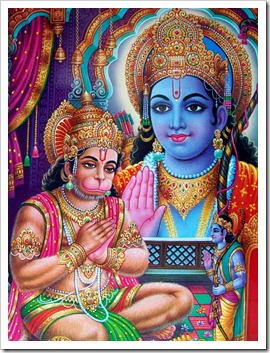 Those who were initially reluctant to take to chanting but then subsequently took it up can elaborate further on the beautiful feeling of being enraptured by the sweet sound of the holy name. Six months is quite a long time, so anyone who chants God’s name in such a regulated manner will certainly shift their consciousness. A siddhi, or perfection, is a great ability, so in this regard those who are able to always keep the activities, names and forms of the Supreme Lord at the forefront of the mind can be considered the greatest yogis. Shri Hanuman, who has mastery over every mystic perfection [an ability he acquired without any strenuous endeavor], spends all his time chanting Rama’s name and thinking of the Lord, His wife Sita Devi, and His younger brother Lakshmana. As Tulsidas’ guru, Hanuman imbibed in the saint the same dedication to bhakti. Therefore whatever recommendations Tulsidas provides actually come directly from Hanuman. Though there are many forms of yoga today, only mantra-yoga built on the sacred formulas describing the endless glories of the Supreme Lord proves to be universally efficacious. Simply by trying the six month formula, wherein a most potent chant like the maha-mantra is recited up to sixteen rounds daily on a set of japa beads, we can see for ourselves whether or not auspiciousness and perfection accompany bhakti. Those who were initially reluctant to take to chanting but then subsequently took it up can elaborate further on the beautiful feeling of being enraptured by the sweet sound of the holy name. Six months is quite a long time, so anyone who chants God’s name in such a regulated manner will certainly shift their consciousness. A siddhi, or perfection, is a great ability, so in this regard those who are able to always keep the activities, names and forms of the Supreme Lord at the forefront of the mind can be considered the greatest yogis. Shri Hanuman, who has mastery over every mystic perfection [an ability he acquired without any strenuous endeavor], spends all his time chanting Rama’s name and thinking of the Lord, His wife Sita Devi, and His younger brother Lakshmana. As Tulsidas’ guru, Hanuman imbibed in the saint the same dedication to bhakti. Therefore whatever recommendations Tulsidas provides actually come directly from Hanuman. Though there are many forms of yoga today, only mantra-yoga built on the sacred formulas describing the endless glories of the Supreme Lord proves to be universally efficacious. Simply by trying the six month formula, wherein a most potent chant like the maha-mantra is recited up to sixteen rounds daily on a set of japa beads, we can see for ourselves whether or not auspiciousness and perfection accompany bhakti. |
Search This Blog
Friday, June 3, 2011
Mantra Yoga
Subscribe to:
Post Comments (Atom)
No comments:
Post a Comment